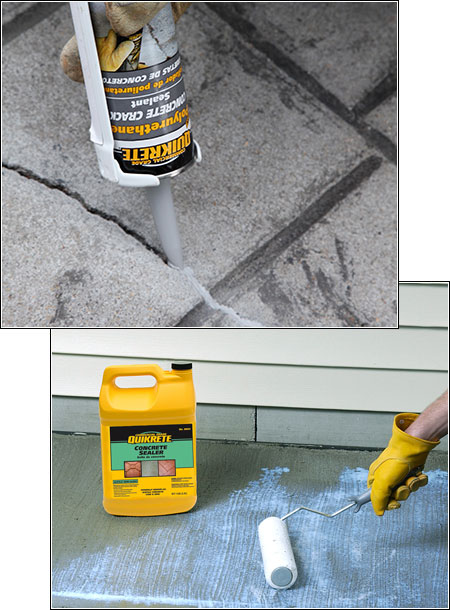 According to the National Climatic Data Center, the average winter temperature in 25 U.S. states is below freezing and that can be very harmful to concrete surfaces left unprotected by homeowners. When rain, snow or ice migrates through cracks in concrete and saturates the substrate, the concrete will shift and move every time freezing and thawing occurs. This repeated movement can cause the cracks to expand or create new ones. Concrete also acts as a rigid sponge that if left unprotected becomes saturated from rain, snow and ice during the winter. When temperatures drop below freezing, the water saturating the concrete expands and can cause the surface to flake or spall. Fortunately, there are some simply projects, products and tips that can help homeowners prepare for these winter challenges.
According to the National Climatic Data Center, the average winter temperature in 25 U.S. states is below freezing and that can be very harmful to concrete surfaces left unprotected by homeowners. When rain, snow or ice migrates through cracks in concrete and saturates the substrate, the concrete will shift and move every time freezing and thawing occurs. This repeated movement can cause the cracks to expand or create new ones. Concrete also acts as a rigid sponge that if left unprotected becomes saturated from rain, snow and ice during the winter. When temperatures drop below freezing, the water saturating the concrete expands and can cause the surface to flake or spall. Fortunately, there are some simply projects, products and tips that can help homeowners prepare for these winter challenges.
- Use a flexible polyurethane sealant like QUIKRETE® Polyurethane Concrete Crack Sealant that allows concrete to move and shift without damaging the repair
- Widen the existing crack to minimum of 1/4-inch with a hammer and chisel, and clean debris from the crack with a brush
- Fill the crack with QUIKRETE® Polyurethane Concrete Crack Sealant level to the surface using a standard caulk gun
- Consider this project how-to video at www.quikrete.com/AtHome/Video-Sealing-Waterproofing-Cracks-in-Concrete.asp
- Use a water-based acrylic sealer like QUIKRETE® Concrete Cure & Seal to waterproof and protect concrete surfaces from flaking or spalling
- Clean the surface with a pressure washer and/or cleaner like QUIKRETE® Concrete & Asphalt Cleaner to remove all dirt, grease, salts and other bond inhibitors
- Apply the sealer evenly on the surface using a garden sprayer, roller or brush – a second coat can be applied two hours after initial application
- Transform old, worn concrete driveways, sidewalks and patios into new, durable surfaces with a resurfacer like QUIKRETE® Concrete Resurfacer
- Clean all the deteriorated concrete, dirt, grease, salts and other bond inhibitors from the surface with a 3,500 PSI pressure washer
- Mix the QUIKRETE® Concrete Resurfacer to a flowable consistency and evenly apply to the surface no thicker than 1/4-inch with a long-handled squeegee; a non-skid finish can be applied with a broom
- The resurfaced concrete can be walked on in six hours and driven on in 12 hours
- Consider this project how-to video at www.quikrete.com/AtHome/Video-Resurfacing-Concrete-Slabs.asp
More information on QUIKRETE® products and access to home improvement project how-to videos are available at www.quikrete.com, Facebook and Twitter.

